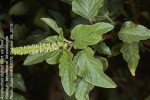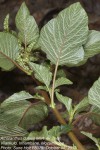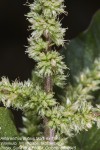| Home | > | List of families | > | Amaranthaceae | > | Amaranthus | > | dubius |
Amaranthus dubius
Selected images: Click on each image to see a larger version and details of the record View all images (5)
Detailed records: Display species records QDS maps by: Google Maps Point records by Google Maps
Species details: Click on each item to see an explanation of that item (Note: opens a new window)
| Synonyms: |
Amaranthus patulus sensu Baker & Clarke in F.T.A. 6, 1: 33 (1909) non Bertol. Amaranthus tristis sensu Moq. in DC., Prodr. 13, 2: 260 (1849) non L. |
| Common names: | |
| Frequency: | |
| Status: | |
| Description: |
Erect annual herb, mostly up to c. 90 cm, rarely taller. Stem rather slender to stout, usually branched, mostly hairless or with short to rather long hairs upwards, especially in the inflorescence. Leaves ovate or rhomboid-ovate, 1.5–12 cm long. hairless or thinly and shortly hairy on the veins beneath; petiole up to c. 8.5 cm long, sometimes longer than the leaf blade; leaf axils without spines. Flowers green, in axillary clusters 4–10 cm in diameter in the lower part of the plant; towards the ends of the stem and branches leafless clusters form simple or branched spikes c. 3–15 cm long and 6–10 mm wide. Lower flower clusters entirely female, spikes generally showing a few male flowers at the apices only, occasionally with male flowers also scattered among the lower female flowers. Bracts and bracteoles deltoid-ovate, pale-membranous with an erect reddish awn, bracteoles somewhat shorter than or equalling the perianth, rarely slightly exceeding it. Perianth segments mostly 5, in female flowers narrowly oblong or spathulate oblong, c. 1.5–2.75 mm long; in male flowers broadly lanceolate or lanceolate-oblong. Capsule subequalling the perianth, ovoid-urceolate, with a short inflated beak below the style base, c. 1.5–1.75 mm, circumcissile, the lid strongly rugulose below the neck. |
| Type location: |
cultivated specimen |
| Notes: | |
| Derivation of specific name: | dubius: uncertain, doubtful |
| Habitat: | |
| Altitude range: (metres) | |
| Flowering time: | |
| Worldwide distribution: | native in tropical America but now almost throughout the tropics of the world. |
| National distribution: | |
| Growth form(s): | |
| Endemic status: | |
| Red data list status: | |
| Insects associated with this species: | |
| Spot characters: | Display spot characters for this species |
| Literature: |
Da Silva, M.C., Izidine, S. & Amude, A.B. (2004). A preliminary checklist of the vascular plants of Mozambique. Southern African Botanical Diversity Network Report No. 30 Sabonet, Pretoria Page 144. Mapaura, A. & Timberlake, J. (eds) (2004). A checklist of Zimbabwean vascular plants Southern African Botanical Diversity Network Report No. 33 Sabonet, Pretoria and Harare Page 16. Phiri, P.S.M. (2005). A Checklist of Zambian Vascular Plants Southern African Botanical Diversity Network Report No. 32 Page 20. Townsend, C.C. (1988). Amaranthaceae Flora Zambesiaca 9(1) Pages 48 - 51. (Includes a picture). |
Other sources of information about Amaranthus dubius:
Our websites:
Flora of Malawi: Amaranthus dubiusFlora of Mozambique: Amaranthus dubius
Flora of Zambia: Amaranthus dubius
Flora of Zimbabwe: Amaranthus dubius
External websites:
African Plants: A Photo Guide (Senckenberg): Amaranthus dubiusAfrican Plant Database: Amaranthus dubius
BHL (Biodiversity Heritage Library): Amaranthus dubius
EOL (Encyclopedia of Life): Amaranthus dubius
GBIF (Global Biodiversity Information Facility): Amaranthus dubius
Google: Web - Images - Scholar
iNaturalist: Amaranthus dubius
IPNI (International Plant Names Index): Amaranthus dubius
JSTOR Plant Science: Amaranthus dubius
Mansfeld World Database of Agricultural and Horticultural Crops: Amaranthus dubius
Plants of the World Online: Amaranthus dubius
Tropicos: Amaranthus dubius
Wikipedia: Amaranthus dubius
| Home | > | List of families | > | Amaranthaceae | > | Amaranthus | > | dubius |




